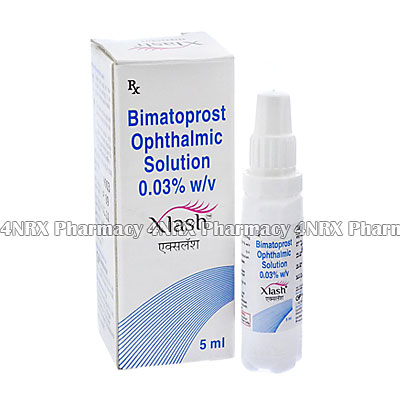 |
Home  Eyes Eyes  Xlash (Bimatoprost) Xlash (Bimatoprost) |
|
|||||||||
|
Xlash (Bimatoprost)
What is Xlash (Bimatoprost) used for? Xlash (Bimatoprost) is prescribed to patients without eyelashes or who have an inadequate amount of eyelashes. It stimulates the existing lashes and follicles to produce thicker, darker, and healthier eyelashes. Eyelashes may eventually return to their original state in length and thickness. This medication only benefits the user whilst being used, once the user has stopped using it. It may also be prescribed for the treatment of glaucoma or other conditions causing high pressure inside the eyes. How should I use Xlash (Bimatoprost)? Before applying Xlash (Bimatoprost) always remove contact lenses, as well as any make up around the eyes. Then gently shake the bottle to thoroughly mix the solution inside. Place one drop of the solution onto the applicator brush, then carefully apply the drop to the eyelashes taking special care not to touch the eyes. Always apply to the upper side of the top eyelashes. Application is usually once per day, and needs to be consistently done for 2 to 3 months before seeing an improvement. Always recap the bottle immediately after use to help prevent contamination. What are the side effects of Xlash (Bimatoprost)? Xlash (Bimatoprost) is usually well tolerated and any side effects are mild and not persistent. If any side effects occur, consult your doctor. Side effects which may occur include dryness, tchiness, irritation, or burning of the eye, discolouration or the iris, excess hair in unwanted area which have come into contact with the medication. Please Note To prevent contamination, do not touch the dropper or allow it to touch any other objects or surfaces. Strictly use Xlash (Bimatoprost) as prescribed and follow all instructions provided by your doctor. Safe, suitable, and optimum dosage can vary and is dependent on the patient's health and medical history, as well as the condition you are treating. Xlash (Bimatoprost) may not be safe or suitable for all patients. Always ensure you doctor is informed if you are pregnant or breastfeeding, using any other type of medication (including non-prescription medicine, vitamins, and supplements), as well as if you have any allergies, other illnesses, or pre-existing medication conditions. Seek immediate medical attention or proceed to your nearest accident and emergency department if you suffer a hypersensitive or allergic reaction. Symptoms usually present during a reaction of this nature include difficulty breathing or swallowing, swelling of the limbs or face, tight chest, hives, and skin rashes. 
|
|||||||||||||||||